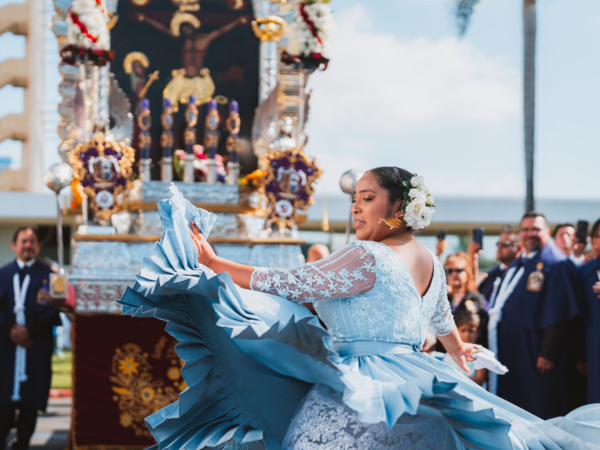The procession of El Señor de los Milagros, or The Lord of Miracles, is one of the most sacred Catholic traditions in Peru and one of the largest religious processions in the world.
The annual celebration has its roots in 1651, when an Angolan slave is said to have painted a mural of Jesus Christ on an adobe wall of a monastery in Lima.
Four years later, an earthquake demolished the city, leveling most of the monastery, but the wall with the mural of Jesus remained intact.
When subsequent earthquakes failed to destroy the wall, Peruvians venerated the miraculous image.
Today, the Lord of Miracles is celebrated over three days with a procession through the streets of the Lima, where hundreds of thousands of worshipers make the pilgrimage, hoping to get even a glimpse of the image as it makes its way through the city on an altar weighing close to two tons.
It takes 32 men to carry the altar.
“You can’t even get close,” said Renan Torres, president of the Lord of Miracles Brotherhood in Orange County. “It’s a procession that goes on for three days. And thousands of people follow it.”
A replica of the mural has taken the place of the original, which is housed in the Sanctuary and Monastery of Las Nazarenas in Lima.
Every October, Christ Cathedral hosts its own El Señor de los Milagros celebration, and while the Mass and the procession that follows doesn’t draw millions, well over 1,000 worshipers were at the Christ Cathedral campus on Oct. 28 to celebrate Mass and participate in the procession that followed.
Donned in purple robes, hundreds of members of the Orange County Chapter of The Lord of Miracles Brotherhood led the procession and carried the altar.
“We follow a tradition of faith that we carry from our parents and grandparents that started in the 17th century,” Torres said. “And it’s a tradition that broke borders and throughout the years keeps growing and growing and our mission is to work for the Word of God. We teach our kids and our grandkids what faith is all about being good people and helping others like helping each other.”
The brotherhood also does charity work locally and in Peru, Torres added.
“This is the day we thank God for all we receive throughout the year,” he said. “We’re active every single day of the year.”
Baldo Paseta, who served as the first president of the brotherhood, said the organization has been celebrating El Señor de los Milagos at Christ Cathedral since 2000, after the Diocese of Orange purchased the property.
Paseta has attended El Señor de los Milagros in Lima on several occasions and said his father had the honor of helping to carry the altar in 2002.
“It was the duty and obligation of every Peruvian around the world to profess the love of Christ, to El Señor de los Milagros,” Paseta said. “And whenever you go, actually, whenever you have a group of Peruvians, you always have the brotherhood.”
The altar used in the Christ Cathedral procession weighed approximately 1.3 tons and was carried around Christ Cathedral campus, accompanied by a brass band. The brotherhood constructed a miniature version which was carried by children wearing purple robes.
Unlike the procession in Lima, worshipers can get an up-close look at the altar and image of Christ on the cross.
When singer Suzanne Gutierrez was asked to sing in the choir during the Mass at Christ Cathedral, she had no idea it was for El Señor de los Milagros Mass and celebration.
Gutierrez had heard about the religious celebration but hadn’t seen it before.
“Oh, I think it’s beautiful,” said Gutierrez, a former choir teacher at Holy Name of Mary Catholic School, in San Dimas. “I think it’s a beautiful expression of the culture, beliefs and faith.”
Alexandra Lee, the choir director at Holy Name of Mary School came to support Gutierrez and was also attending El Señor de los Milagros for the first time.
“It was an honor to attend it,” Lee said. “I thought that the music was beautiful and the procession was authentic to the tradition of the real Peruvian procession.”

